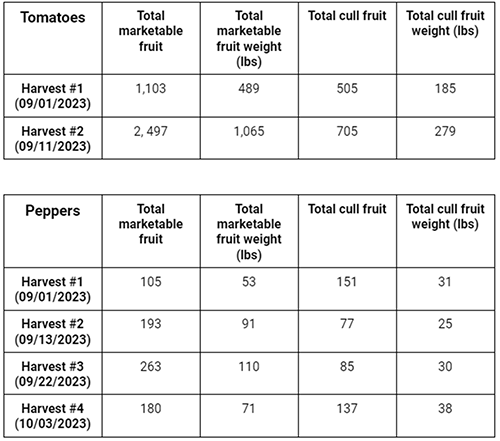March 2024
By Ella VanKempen, Horticulture Researcher II
During the 2023 growing season, the West Central Research and Outreach Center (WCROC) conducted a field variety trial encompassing 10 tomato varieties and 6 pepper varieties, including those in their early stages of development by private industry plant breeders. This breeding initiative aimed to test and find new cultivars that have enhanced yields and heightened disease resistance compared to those currently on the market. The plants were evaluated on traits such as date of maturity, yield, fruit size, weight, and disease presence.
A total of 300 individual tomato plants and 408 individual pepper plants were put in the ground within their given experimental plots. They were planted on June 5 in a raised bed with plastic mulch over the top to control soil moisture, protect the plant root zone, and suppress weeds. The plants were watered with a drip irrigation system placed under the plastic mulch and watered around three times a week.
Flowering for a majority of the plants was observed on July 5th, and matured for harvest by September. The tomato trial required two harvests spaced 10 days apart where we picked both the good fruit and cull fruit for counting and weighing. The pepper trial adhered to a parallel harvesting regimen with additional measurements to classify whether the peppers were Fancy, Number 1, or Number 2 grade based on individual fruit size and measurement. For the pepper varieties, 4 separate harvests also about 10 days apart were conducted throughout the month of September. With help from dedicated volunteers and the summer horticulture crew, the harvests were completed by early October. Below is the data collected.

After the tomatoes were harvested, weighed, and recorded, some were kept to distribute amongst staff at the WCROC while a large majority of them were given to the dining hall at the University of Minnesota - Morris, the local elementary school, and the Stevens County Food Shelf. The same was done after each harvest of peppers in practice of sourcing local food. Plants were pulled up from the ground at the end of our data collection period and one of each variety was sent to the University of Minnesota’s plant disease clinic to check for any present diseases. Their information as well as the data we collected was sent back to the plant breeding company for them to evaluate and analyze for future plant development.
